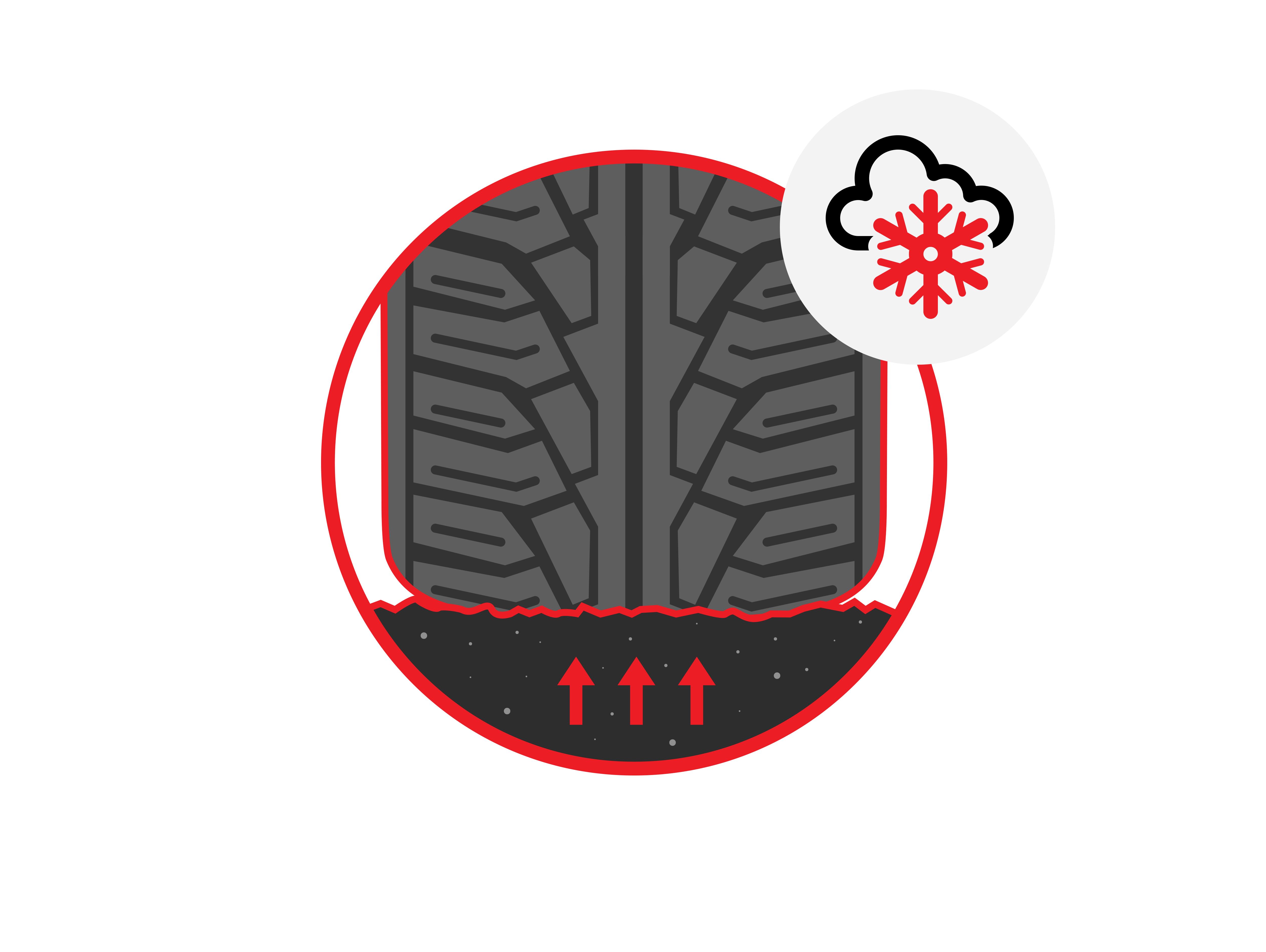
If you want to carry on enjoying driving all year round, you need to think about preparing your car for winter. The following checks are easy to do and don’t require any special mechanical knowledge.
Check your levels
Without really thinking about it, we naturally prepare ourselves for winter. We put our summer clothes away and dig out our jumpers. We order logs for the fire or get the electric heater out of storage. We even change the sorts of food we eat. In fact, we do all we can to ensure that live carries on as normal, despite the drop in temperature.
The first step in preparing your car for winter is to check your oil, windscreen wiper fluid and water/engine coolant levels. Park your car on a flat, level surface and wait until the engine is cold.
The water/engine coolant level needs to be between the minimum and maximum lines on the gauge to stop your engine freezing or overheating. If you need to top it up, make sure you use the correct ratio of water to coolant/antifreeze.
With the windscreen wash, it’s as simple as checking the levels on the bottle, topping it up with water and screenwash additive and replacing the cap.
Don’t forget to check:
- Oil levels
- Windscreen washer fluid
- Water/engine coolant
- Tyres
- Wiper blades
- Lights
- Battery strength
Finally, the oil. Remove your dipstick, wipe off the excess oil with a rag, refit the dipstick and remove again. You’ll see some minimum and maximum marks on the end of the dipstick. If you find your oil needs topping up, remove the oil cap and add the oil bit by bit, rechecking with the dipstick as you go. It’s very easy to overfill so take it slowly.
Check your tyres

When you’re preparing your car for winter, it’s important you make sure your tyres (including your spare) are in good condition and that they have plenty of tread to last you through the season. Look out for any uneven wear, cuts, bulges or damage to your wheels and, if you spot anything you’re worried about, ask your local Uniroyal dealer to check it over. As always, check your tyre pressures regularly.
Check your wiper blades

Your wipers will get lots of use in the winter, so it’s important that they’re in good condition. Run your fingers along the length of the rubber blade to check for any splits or cracks. Replace if necessary.
Check your lights

Again, lights are used more during winter than at any other time of the year. And it may be the first time for a while that you need to use your fog light. Ask a friend to help you check all your lights and replace any bulbs where necessary. Finally, make sure the lenses are clean with no cracks.
One last thing – and this may require a trip to your local garage – it’s a good idea to have your battery checked. Your mechanic should be able to see how much life it’s got left in it and can change it if it’s likely to let you down.
Packing a winter emergency kit
Winter emergency equipment for your car
However good your driving, things can go wrong. And the last thing you need is to be unprepared. Packing a winter emergency kit is relatively cheap and it could come to your rescue if you have an accident or break down.
Your winter emergency kit
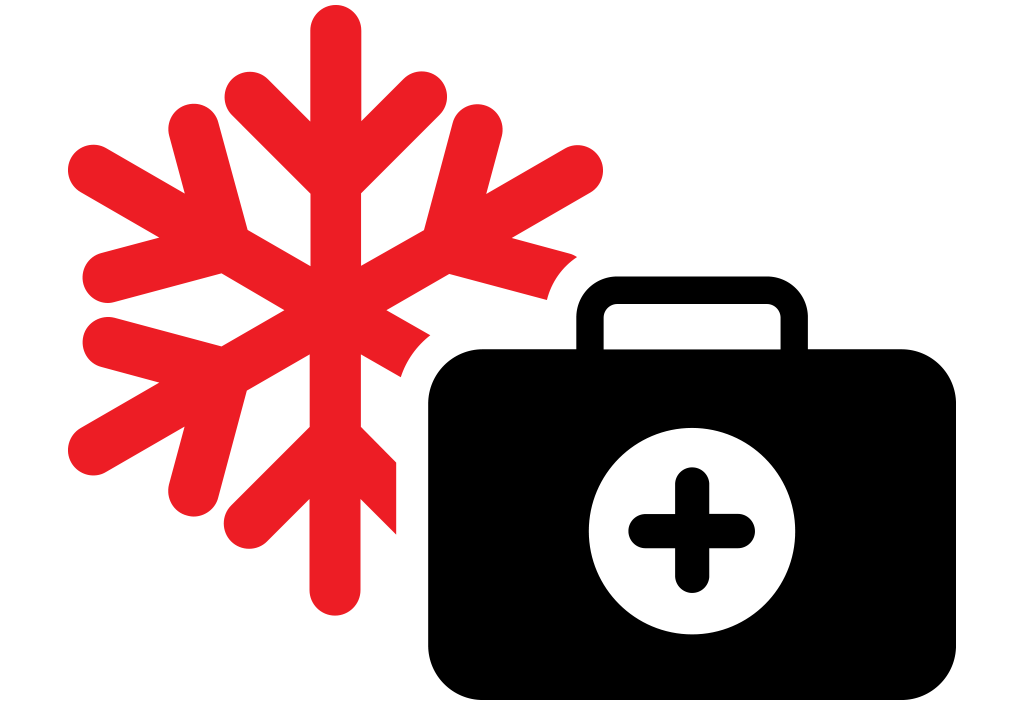
So what should be in your winter emergency kit? It’s all about preparing for the worst and hoping for the best. Imagine being stuck for a while in cold conditions while you wait for help to arrive. A warm blanket or sleeping bag will definitely help.
Let’s say the weather changes on you. You’ll want to have a shovel on board as well as an ice-scraper and cans of de-icer. It’s also worth carrying extra screen wash.
It’s always a good idea to carry a torch to help you find your way in the dark and to help others find you. Just make sure that you check the batteries regularly or buy a wind up torch. Speaking of others finding you, always carry a reflective warning triangle and a Hi-Viz vest.
Remember, your usual phone charger won’t work if your battery fails so it’s worth investing in a wind up mobile phone charger or a portable power pack.
If your battery does fail, you may need to ask for a jump start. Don’t assume the other person will have jump leads on them – it’s far better to carry your own.
As well as a first aid kit (useful all year round), your winter emergency kit should also include snacks like chocolate or cereal bars.
At its very basic, your winter emergency kit should include:
- A warm blanket
- Shovel
- Ice-scraper and de-icer
- Screenwash
- Wind-up torch
- Warning triangle
- Hi-Viz vest
- Wind-up phone charger
- Jump leads
- First Aid Kit
- Snacks
Your pre-journey top up kit
If you’re about to set out on a journey, and you know bad weather is forecast, you may want to bulk up your winter emergency kit with some added extras. For example, pack a whole set of warm clothes, including a scarf, hat, gloves and thick socks as well as a winter coat and even some pocket warmers. If rain is forecast, think about wellington boots, waterproof trousers and a raincoat. And take a hot drink with you, or some soup, made up in a flask.
Leaving for winter holidays by car
How to prepare your car
Winter holidays are great fun. So the sooner you get there, the sooner you’ll start to enjoy yourself. Just make sure you’re aware of the unique challenges that can happen on trips to the mountains.
What should I check?
First of all, check everything’s working properly and that your tyres are fit for the journey. You can see if you’ll need winter tyres at your destination by reading our article where are winter tyres mandatory in Europe. Essential checks include your lights, wipers and battery. You’ll find more information in our guide to preparing your car for winter.
Secondly, and this is very important, read up about the local driving laws where you’ll be driving. Do not assume that they’re the same across Europe.
How should I load the car?
It’s very important that you don’t exceed the maximum load and that you keep weight evenly balanced (particularly if you’re using a roof box). Make sure that the driver has clear visibility through the back window.
In terms of stacking luggage, remember that luggage can move forward if you have to brake suddenly. We therefore recommend that you load heavy luggage first and, wherever possible, anchor it behind rear seats or a partition net. Lighter luggage can then sit on top of it. A good tip is to put clothes and soft toys in vacuum bags to reduce volume.
Do I need a roof rack?
That’s entirely up to you and depends on what you’re taking with you. If, for example, you’re packing skis and poles, you might find it a lot easier to buy a ski holder or long roof box than try to squeeze them inside the car.
What else should I pack?
Take a look at the weather forecast before you leave and find out what the local regulations are regarding snow chains (they are mandatory in some areas).
It makes sense to pack a windscreen snow cover too so you’re not held up scraping your windows every morning during your holidays. Extra tip: If you need to use a de-icer and windscreen wipers to clear your windows, let the wipers go in one direction then stop them and wipe with a clean cloth. This avoids dirt being rubbed back and forth, scratching your glass in the process.
Children get bored on long journeys so don’t forget to pack some entertainment for them. Tablet computers can be life savers!
And speaking of life savers, find out how to pack a winter emergency kit.
What do I need to consider when driving?
If you drive in the mountains you’ll probably come across a lot of tunnels. Take extra care to stick to the speed limit and drive at a safe distance behind the car in front. Accidents in tunnels cause real problems leading to long tailbacks.
If you’re caught in a tunnel jam you need to be mindful of ventilation and pollution. The best thing to do is to cut off your engine. If, for whatever reason, you’re asked to leave your vehicle, you must leave your keys in the ignition so that emergency crews can move your car if necessary.
Remember too that you may need to keep your sunglasses handy. Although it may be dark in the tunnel, you could come out to very bright sunshine and white snow.
Take extra care when driving over bridges and overpasses or along dense forest roads. These are most susceptible to ice so keep your speed down and your braking distances long.
For more detailed information read our articles how to drive in icy conditions and how to drive in snow.
Tyre changing equipment to keep in your car
Top things to keep in your car
It’s a good idea to keep a range of tools and tyre changing equipment in your car so that you’re well prepared in case you have to repair or replace your tyre by the side of the road.
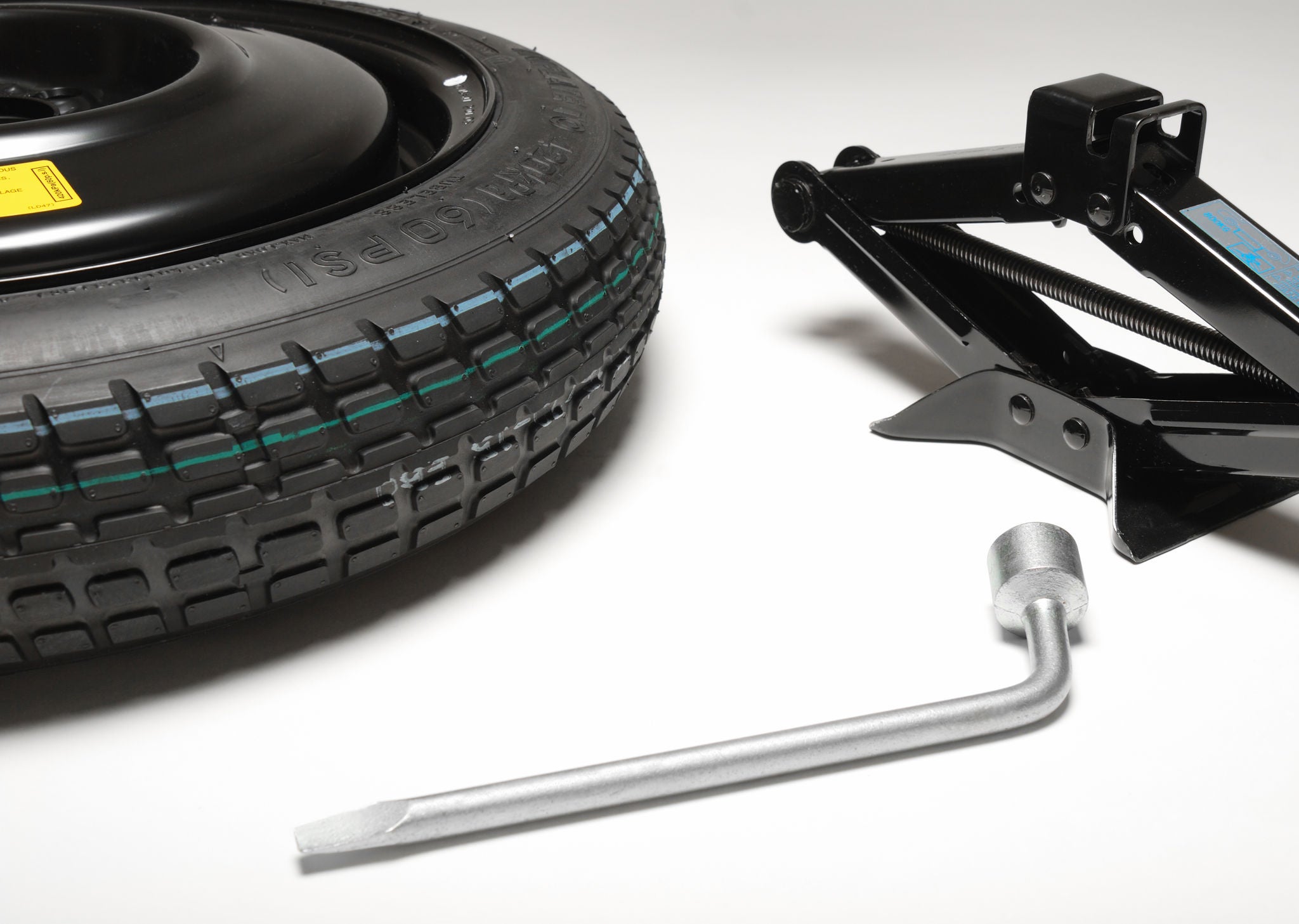
Always keep tyre changing equipment or a tyre repair kit in your car. They could provide valuable temporary help until you can get to your local Uniroyal dealer. At the very least you should carry:
1. A spare tyre
2. A jack
3. A wheel wrench with extension bar
4. A locking wheel-nut adapter (if appropriate)
5. A tyre repair kit
6. Your vehicle’s handbook
Check what you’ve already got
If you’ve bought your car second hand, it’s important that you check that all the tools provided by the manufacturer, including tyre changing equipment, are still in place. Don’t just assume they’re there. You’ll find a full list in your handbook.
If your car has a spare wheel, you should have been given a jack, a wheel wrench with extension bar and, if appropriate, a locking wheel-nut adapter.
Of course, many cars don’t have a spare wheel so, if that’s the case, check that you have a complete post-puncture repair kit with spare CO2 canisters (or a pump) and sufficient glue. These are an alternative to the tyre changing equipment provided with spare tyres.
Your vehicle handbook should always stay in the car and it is one of the most useful pieces of equipment you’ll need. Each make and model of car has its own peculiarities and your handbook will tell you specific details as well as what to do if you need a roadside repair.
Other items to consider
Some other less essential, but still useful, things to keep in your car are:
- A wheel chock (to stop your car rolling when it’s jacked up)
- A tyre pressure gauge
- Scissors to remove cable ties from your wheel trims
- A reflective jacket or Hi Vis vest
- An emergency triangle
- A torch
- A pair of gloves
- An old towel or cushion to kneel on
- A first-aid kit – in case you hurt yourself changing the wheel
- Details of your roadside repair provider plus your account details.
Ten things you should always keep in your car
These things can make your life easier
As well as carrying a winter emergency kit, pack some other little extras to make life easier. Here’s how our top ten suggestions can save the day if you stop for a break or even break down:
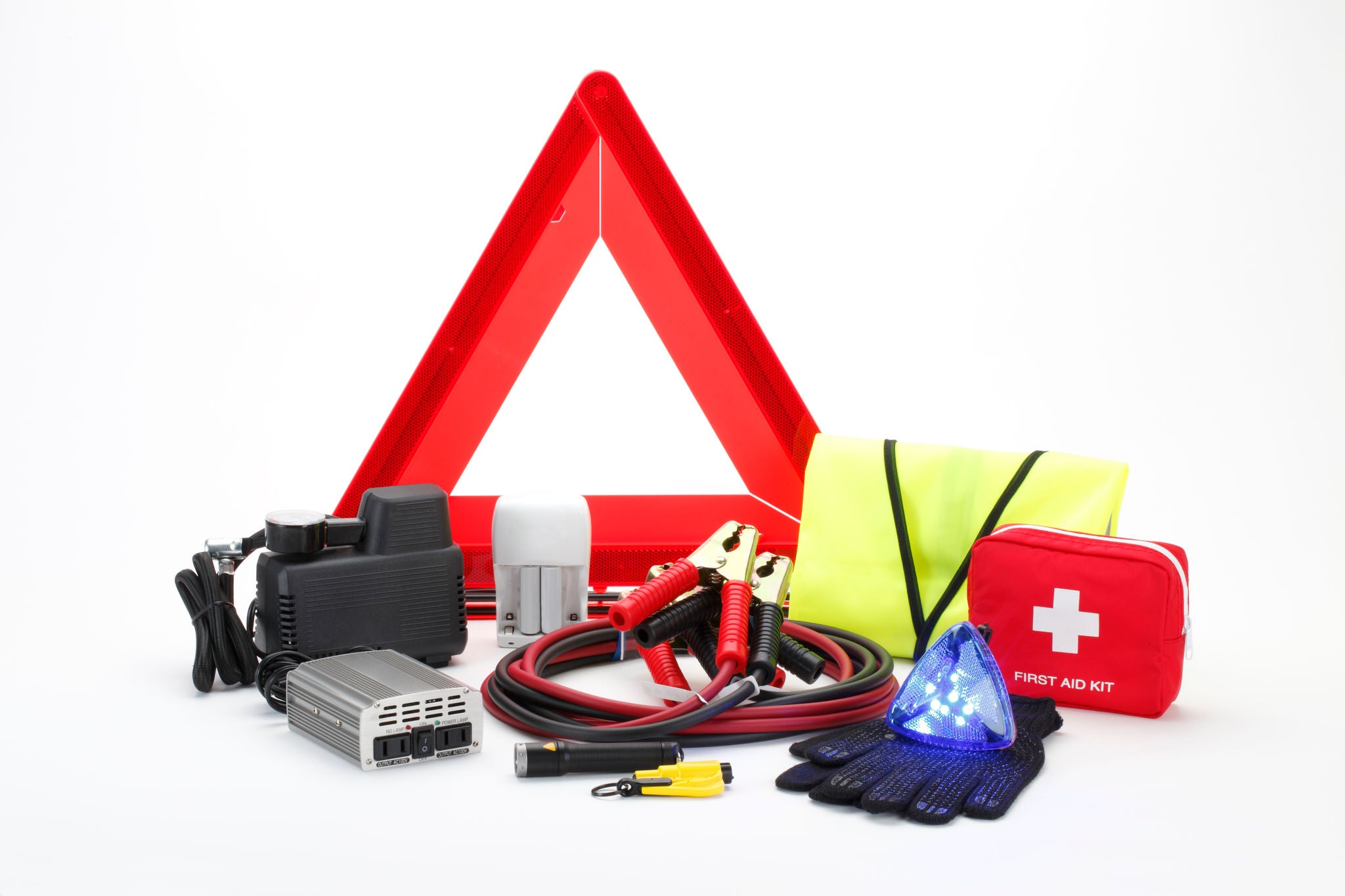
- Duct tape. This versatile pressure-sensitive tape is an absolute must-have for all sorts of jobs – from temporary body work repairs to roadside first aid.
- A hand-crank torch. Not only will it help you determine the problem, but it will help others find you after dark. And you won’t need to worry about leaking or worn out batteries.
- A pair of work gloves. As well as keeping you warm, you may need an extra layer of protection if you’re wrestling with wheel nuts or needing to touch hot engine parts.
- A multi-tool. No-one wants to carry a full tool box everywhere they go. But a multi-tool will cover all your basic needs.
- A blanket. Again, another multi-purpose accessory. You can use it to keep warm, or protect you from the sun. A Mylar blanket (foil survival blanket) offers superior thermal protection and can be used for loads of additional tasks. For example, you can use it to catch rain, for a water supply, dry your clothes and even attract attention thanks to its shiny surface.
- A bucket. Buckets have so many uses – from collecting rainwater to providing emergency toilet facilities. While they may be bulky, you can either use them as storage or buy a collapsible version.
- A car-adapted phone charger. An everyday essential. Keep your hands-free phone plugged in when you drive and you’ll always have a charged phone when you need it. You might also want to consider a wind-up charger in case of emergencies.
- Paper towels. Almost too many uses to mention – from wiping bugs off windscreens to food off children’s faces. Plus, of course, you’ll need paper towels when checking your oil levels.
- Seatbelt cutter/window breaker tool. Hopefully you’ll never need this 2-in-1 tool but, if you did find yourself trapped in a car, it could be a real lifesaver.
- A barbecue lighter, an empty coffee can and tea light candles. If you become stranded on a cold night, you’ll certainly benefit from this impromptu heat source. Simply put the tea lights into the coffee tin and rest it on a stable, level, heat-resistant surface. You should get up to four hours’ heat.
How to open frozen door locks
Our quick aids for cold fingers on frosty days
It doesn’t take a lot of water to freeze your car locks but, when it happens, it can create a lot of problems. The good news is that there are several ways to open frozen car door locks.
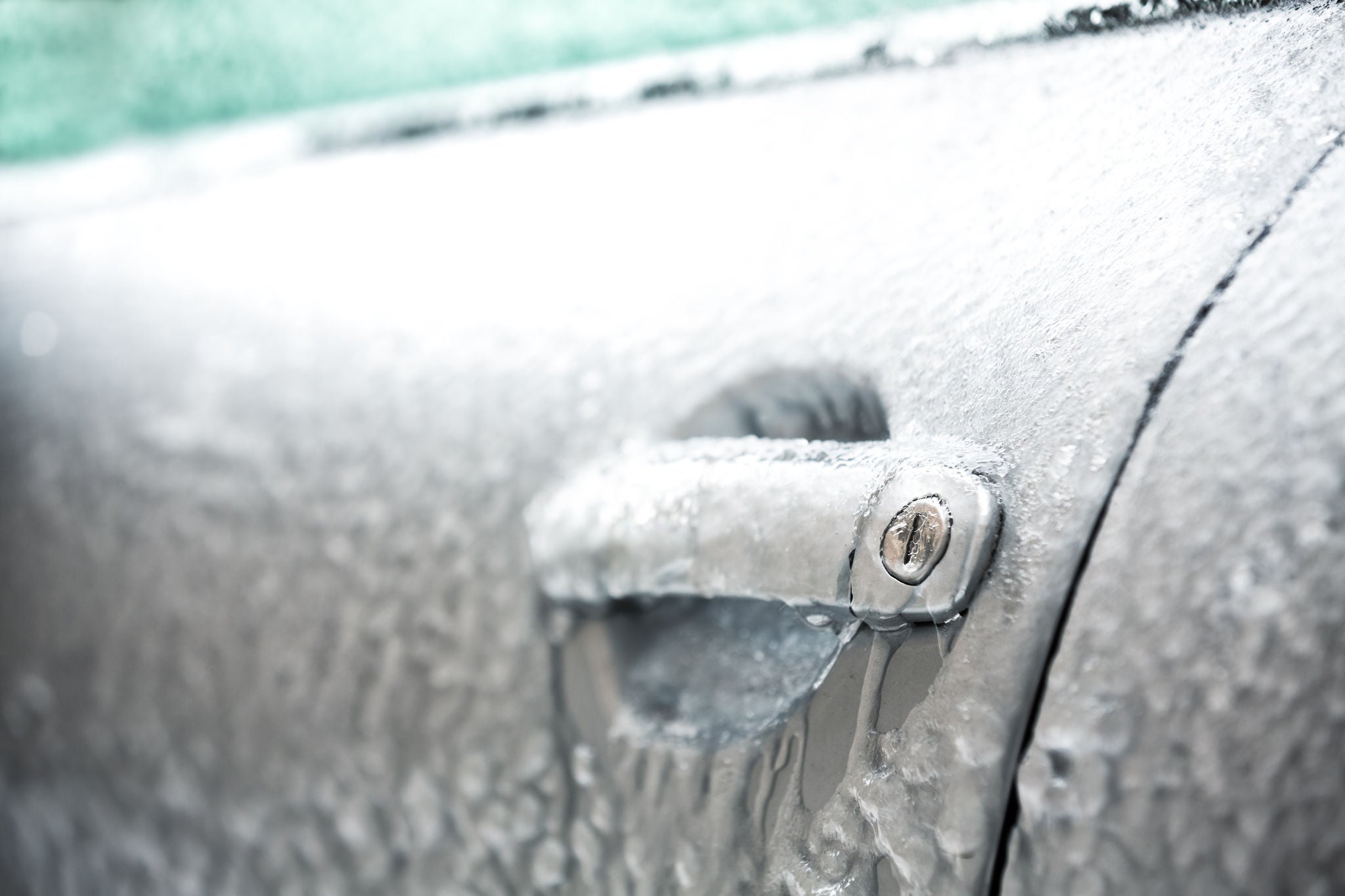
How to open frozen car doors. You could:
- Use an aerosol de-icer or WD-40
- Try a de-icer with a heating element
- Warm your key gently with a flame
- Use your warm breath to blow into the lock cylinder
- Defrost the lock with a hairdryer
- Whatever you do, do not use boiling water
Discover your options
First of all, check if all your doors are affected. You only need one door to open to be able to squeeze into the driving seat, turn over the engine and get the car’s heating system on.
If that’s not possible, the quickest and easiest answer is to use a lock de-icer. These come in two forms: an aerosol with a special nozzle that directs de-icer straight into the lock or a heating element which warms up in the lock, melting any ice that’s formed. Some people find that spraying WD-40 directly onto the key has a similar effect. De-icer and WD-40 aerosols can also be used to prevent ice forming in the first place.
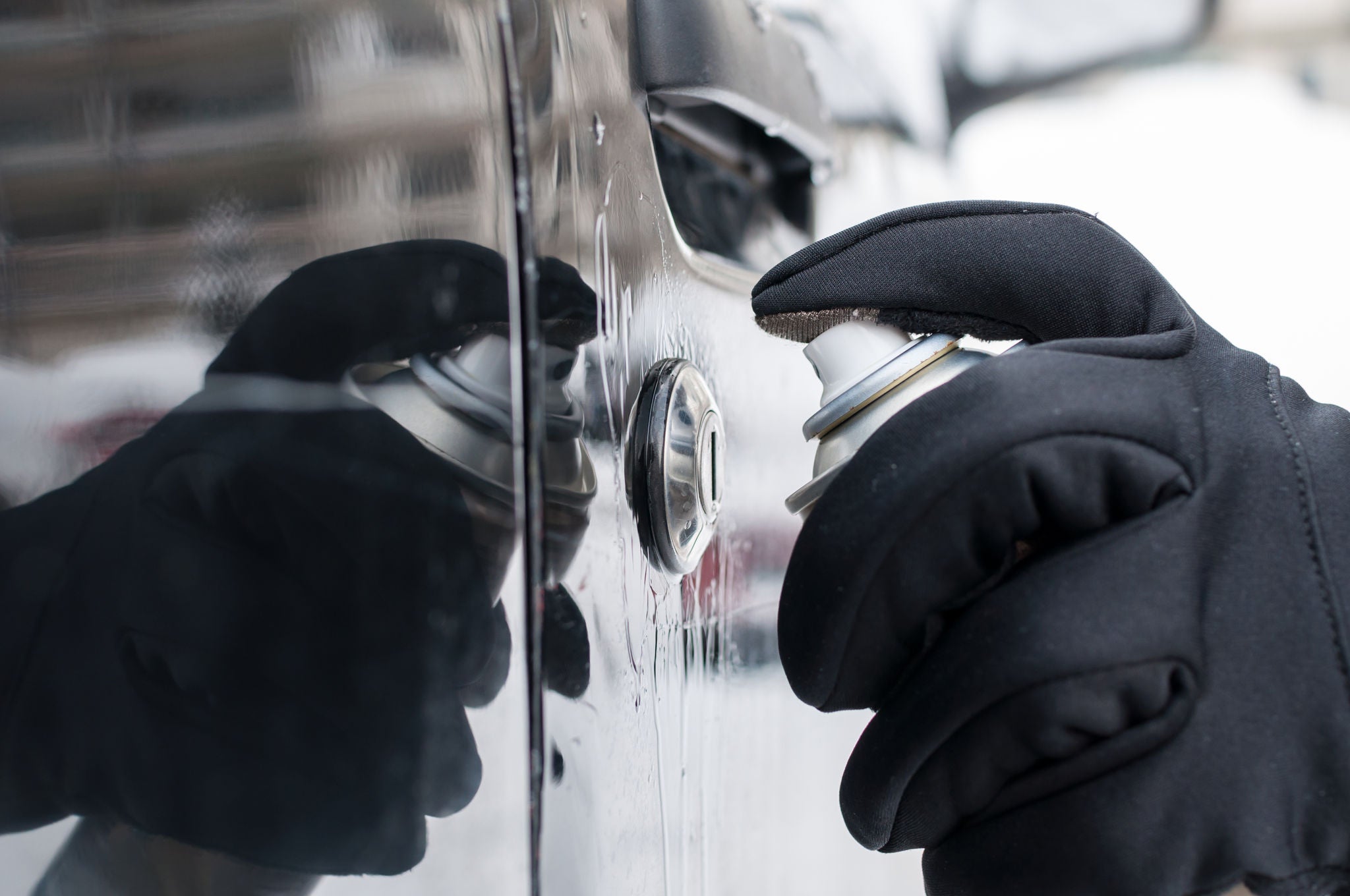
You can create the same effect as the heating element by using matches or a cigarette lighter to gently warm your key. Don’t make it hot, just warm to the touch – and make sure the naked flame doesn’t go anywhere near the remote control buttons, as this could damage the computer chip.
If you have a straw, you can also place this over the lock and blow warm air into the lock cylinder.
If you’re close enough to your house to be able to trail an extension lead, try using a hairdryer to open your frozen car door lock. A hairdryer is also useful if the door seal has frozen.
Another way to get around a frozen seal is to push as hard as you can against the door. The pressure should break any ice and so allow you to open the door.
Whatever you do, do not pour boiling water into the lock. Not only could this damage any plastic components but most modern cars have electronics within their lock cylinders.
What to do if you're stuck in snow?
Here's what you need to do
If there’s been a snow dump while your vehicle’s been parked, or the tyres you’ve fitted simply weren’t up to the job and you’ve veered off the road, you may find yourself stuck in snow.
Work out where the problem is
First of all, check all around the vehicle. You’ll need to see if the exhaust pipe is clear of snow. If not, clear it by hand. Then move any snow away from around each tyre. Ideally you’ll have a shovel in your car as part of your emergency winter kit but, if not, improvise with whatever’s available. As far as possible, try to break up any ice that’s formed under your tyres.
Depending on whether you’re intending to reverse out of the snow, or drive forwards, you will also need to get rid of any snow between your tyres and the exit route.
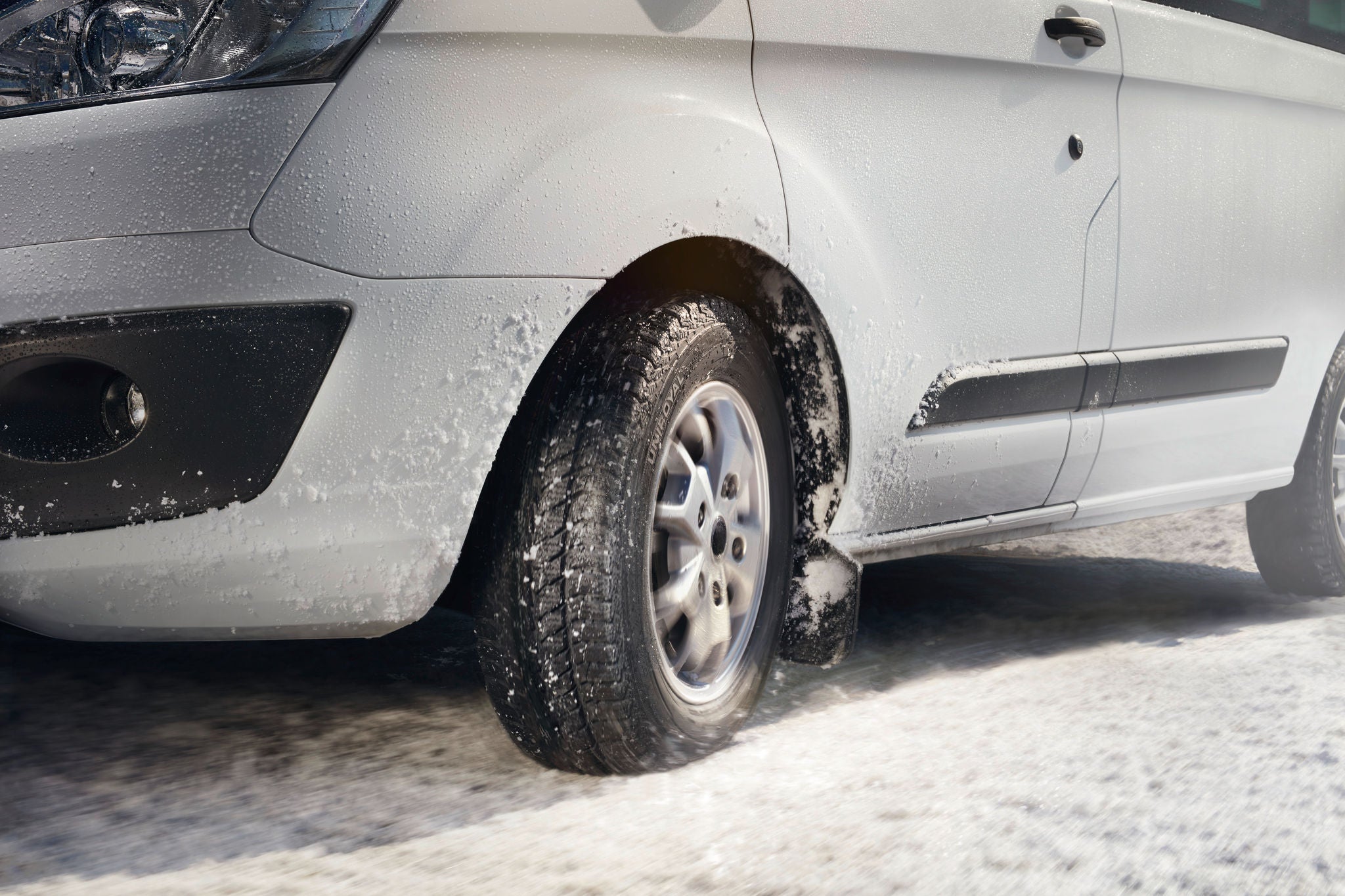
What to do if you’re stuck in snow
- Clear any obvious snowfall
- Disengage your traction control
- Ask people to help rock the car back and forward
- Pull away, slowly, in a low gear
- If this fails, lay matting under the driving wheels
- Alternatively sprinkle salt, sand or cat litter
- Use some antifreeze if necessary but clear it up afterwards
- Re-engage your traction control once you’re back on the road
Get behind the wheel
Now start the car. Disengage your traction control system (there’s usually a button for this on the dashboard somewhere) and put the car into the lowest gear. Whatever you do, don’t slam your foot on the accelerator. All this will do is spin your tyres and dig yourself into more trouble.
If you’re stuck in snow, you’re going to need to get some help to get you out. While you’re pulling away, slowly, ask one or two people to assist you by rocking the car back and forward to try to get it out of any ruts. Drive with your wheels pointing straight and move back and forth until you have enough grip to pull out. You may have some success, if that fails, by turning your front-wheel drive wheels in a different direction.
If that doesn’t work you can try putting some matting down in front of the driving wheels (front wheels on a ‘front-wheel drive’, rear wheels on a ‘rear-wheel drive’). If you can’t get your hands on carpet, you can use your car’s floor mats – although expect them to be ruined. You could also use branches but be aware that anything you put under your tyres could get spun out and potentially hit the people who are trying to help you.
Another alternative, if you’re stuck in snow, is to sprinkle salt, sand or even cat litter in front of your driving wheels. The salt will help to melt the ice while the sand/cat litter will help add traction. You can also try to melt the snow and ice with antifreeze but make sure you clear this up afterwards as antifreeze can be very poisonous to animals.
You can get more friction by letting a little air out of your tyres. However, only do this if you have the means to re-inflate your tyres afterwards. It will ruin your tyres if you drive on them without sufficient tyre pressure.
If all else fails, you will have to call for roadside assistance. And don’t forget to reengage your traction control once you’re back on the road.
Related Topics
-
 2023/09/20Summer or winter tyresRead more
2023/09/20Summer or winter tyresRead more -
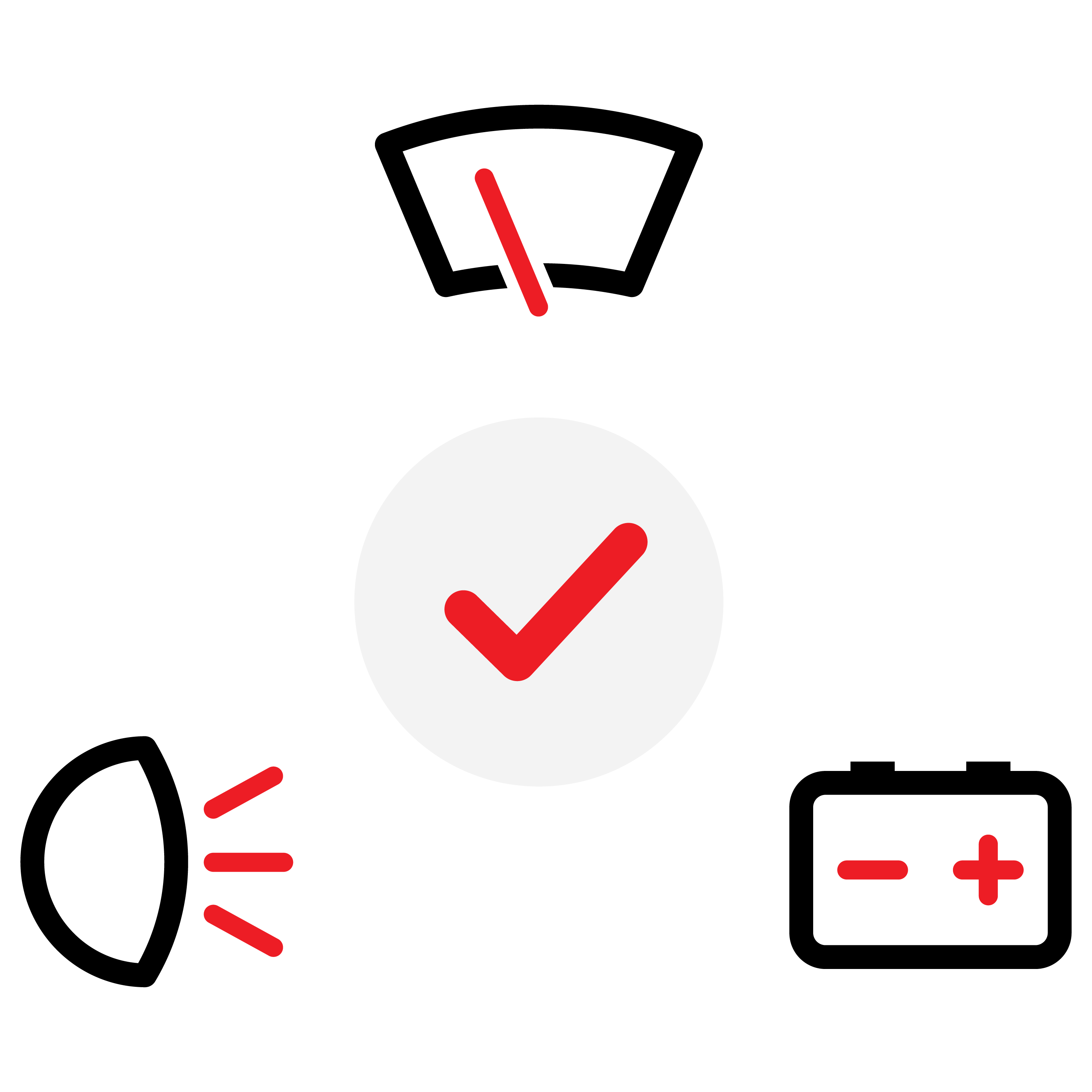 2023/09/20Safety & Driving TipsRead more
2023/09/20Safety & Driving TipsRead more -
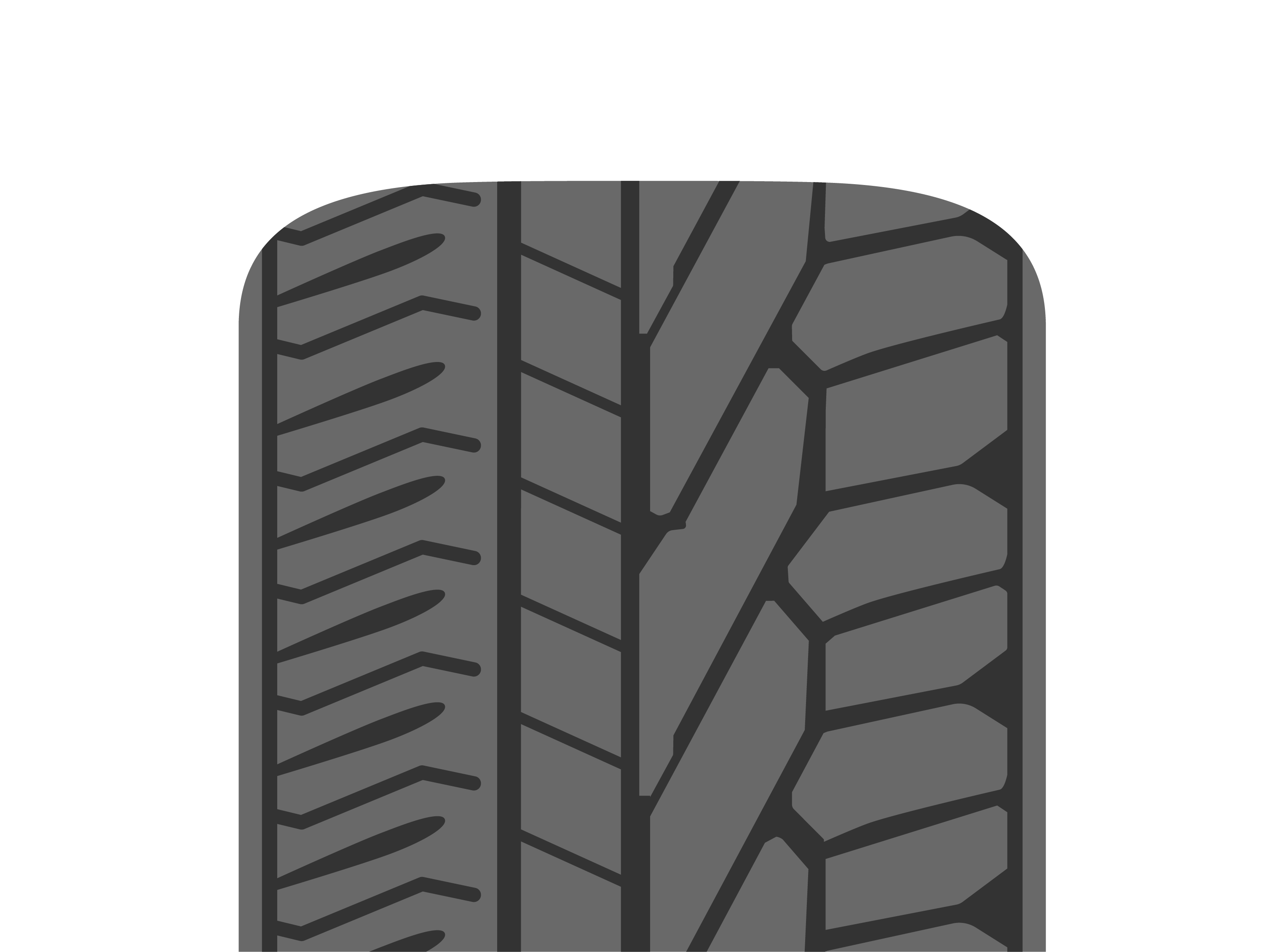 2023/09/20Tyre materialRead more
2023/09/20Tyre materialRead more